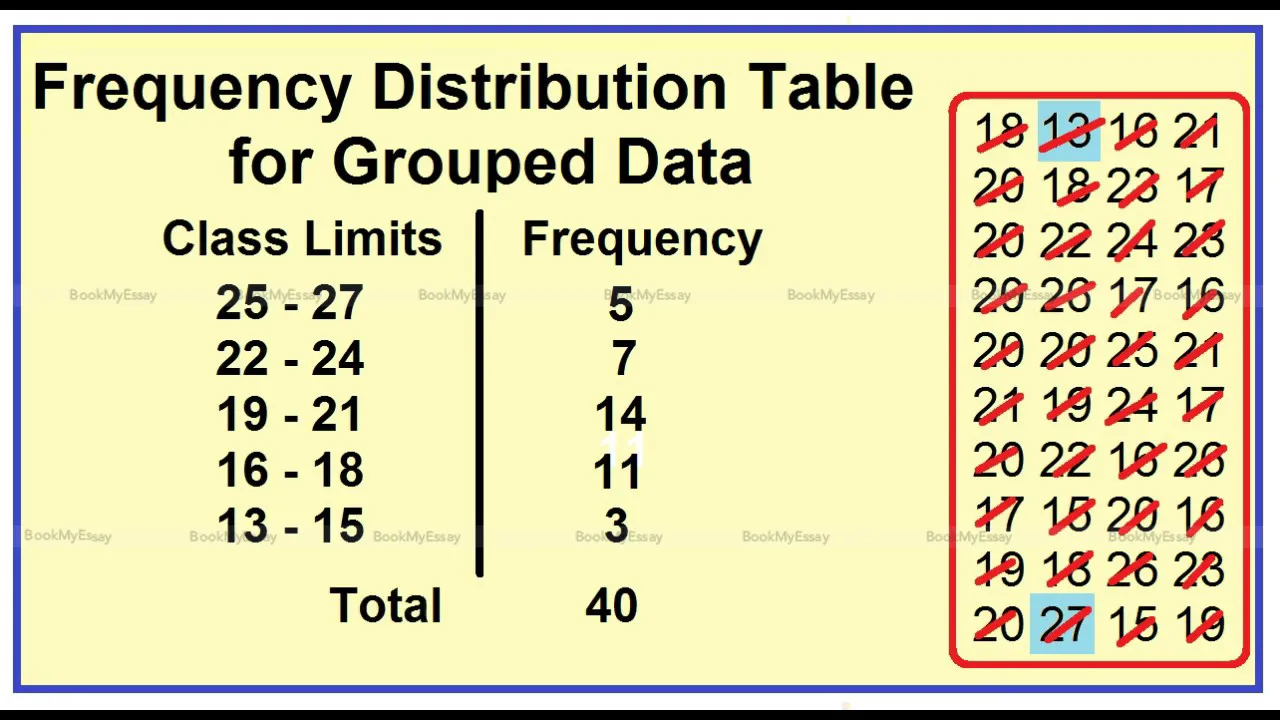Grouped Frequency Distribution
A Grouped Frequency Distribution, depicted through a Grouped Frequency Table, is a statistical method used to organize and summarize large sets of data into intervals or groups, showcasing the frequency of values within each range. It simplifies complex data sets by condensing individual values into broader categories while retaining essential information about their occurrences. This table displays intervals (or classes) along with their corresponding frequencies, making it easier to identify patterns, trends, and distributions within the data. Grouping data helps manage extensive datasets and aids in visual representation through histograms or bar graphs. Organizing data into intervals, it enhances readability and comprehension, allowing analysts and researchers to glean insights efficiently from vast amounts of information, and facilitating informed decision-making in various fields like economics, sociology, and scientific research.
How Should A Frequency Distribution Table Be Interpreted?
Understanding a frequency distribution table is pivotal in algebra homework and math word problems. It's a summary showcasing the frequency of different values within a dataset. Each column represents a distinct value, while the corresponding frequency denotes how many times that value occurs. Interpretation involves grasping the distribution's shape, center and spread. The highest frequency signifies the mode, highlighting the most recurring value. It aids in identifying outliers and understanding the data's variability. For algebra homework writing help or math word problems, interpreting this table unveils essential insights, facilitating accurate calculations and problem-solving. Utilizing a math word problems calculator assignment help may complement this interpretation, aiding in computations based on the distribution's characteristics for precise solutions. Understanding frequency distributions is a fundamental skill, providing a foundation for more complex statistical analyses and problem-solving in various mathematical scenarios.

How Do I Make A Frequency Distribution Table In Statistics?
Creating a frequency distribution table in statistics involves organizing data into distinct categories and tallying the frequency of each category. To start, gather your dataset and determine the range of values. Then, divide the data into intervals or classes, ensuring they're mutually exclusive and exhaustive. Count the occurrences of data falling within each interval and record these frequencies in a table format, displaying intervals in one column and their corresponding frequencies in another. Utilize this table to analyze patterns, central tendencies, and distributions within your data set. For further assistance, seeking "Assignment Help Online" from a reliable math answerer assignment help service can guide in understanding the process, ensuring accurate computations, and effectively presenting statistical information for a comprehensive analysis.
A Variety Of Frequency Distribution Types
Understanding various frequency distribution types is crucial in algebra assignments. Students seeking "Algebra Assignment Help" often encounter tasks involving frequency distributions. There are different types to comprehend, such as normal, skewed, bimodal, and uniform distributions. These distributions depict the spread and patterns within datasets, aiding in mathematical analysis and problem-solving.
For "math word problem solver app assignment help," comprehending frequency distributions is fundamental. Such apps often utilize statistical concepts, requiring a grasp of distribution types to interpret and solve problems accurately. Whether it's creating histograms, analyzing data patterns, or predicting outcomes, a solid understanding of frequency distribution types empowers students to navigate mathematical problem-solving with ease.
Mastering these distributions not only assists in academic writing help but also enhances problem-solving skills, laying a strong foundation for broader mathematical applications.
Comparing Frequency Distributions: Discrete And Continuous
Studying math algebra with smart tricks involves understanding frequency distributions in discrete and continuous forms. In discrete distributions, data is finite and countable, like the number of students in a class. Utilizing smart strategies in algebra, one can efficiently analyze and interpret these distributions, often depicted through histograms or bar graphs. On the other hand, continuous distributions encompass infinite possibilities, such as measuring heights or time intervals, requiring different mathematical approaches. Exploring a website that answers math problems and offers assignment help can aid in comprehending these concepts. Such platforms often provide valuable resources, explanations, and practice materials, enabling students to grasp the nuances of discrete and continuous distributions effectively. Mastering these fundamental statistical concepts enhances problem-solving skills and lays a robust foundation for more advanced mathematical pursuits in algebra and beyond.
How Can BookMyEssay Assist With Grouped Frequency Tables?
BookMyEssay offers exceptional Mathematics Assignment Help, particularly in the realm of grouped frequency tables. When students seek assistance with their math homework, the platform provides specialized support in organizing, analyzing, and interpreting data using grouped frequency tables.
With an expert team well-versed in mathematical concepts, BookMyEssay aids students in understanding the methodology behind constructing and interpreting grouped frequency tables. They offer step-by-step guidance on how to group data efficiently, calculate frequencies, and create meaningful intervals for a clearer representation of data distribution.
Students can rely on BookMyEssay to assist them in comprehending the relevance of grouped frequency tables in statistical analysis. The service aids in interpreting these tables to draw valuable insights, enabling them to apply these concepts effectively in problem-solving and decision-making scenarios.
By availing themselves of BookMyEssay's expertise in mathematics, individuals can confidently say, "Do my math homework," knowing they'll receive comprehensive support in mastering grouped frequency tables and their practical applications.








 3 Bellbridge Dr, Hoppers Crossing, Melbourne VIC 3029
3 Bellbridge Dr, Hoppers Crossing, Melbourne VIC 3029



